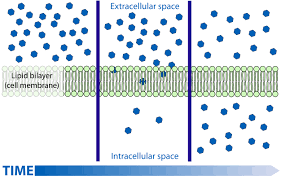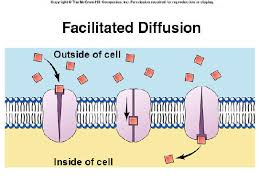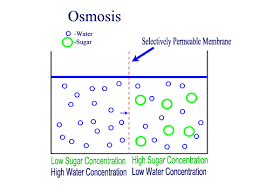
Passive transport means moving biochemicals and atomic or molecular substances across the cell membrane. Unlike active transport, this process does not involve chemical energy. The four main kinds of passive transport are diffusion, facilitated diffusion, filtration and osmosis.
Diffusion is a process in which the random motions of molecules or other particles result in a net movement from a region of high concentration to a region of lower concentration. A familiar example of diffusion is the dissemination of floral perfumes from a bouquet to all parts of the motionless air of a room. The rate of flow of the diffusing substance is proportional to the concentration gradient for a given direction of diffusion. Thus, if the concentration of the diffusing substance is very high at the source, and is diffusing in a direction where little or none is found, the diffusion rate will be maximized. Several substances may diffuse more or less independently and simultaneously within a space or volume of liquid. Because lightweight molecules have higher average speeds than heavy molecules at the same temperature, they also tend to diffuse more rapidly. Molecules of the same weight move more rapidly at higher temperatures, increasing the rate of diffusion as the temperature rises.

Facilitated diffusion is the movement of molecules across the cell membrane via special transport proteins that are embedded within the cellular membrane. Many large molecules, such as glucose, are insoluble in lipids and too large to fit through the membrane pores. Therefore, it will bind with its specific carrier proteins, and the complex will then be bonded to a receptor site and moved through the cellular membrane. The facilitated diffusion is a passive process, and the solutes still move down the concentration gradient.

Filtration is movement of water and solute molecules across the cell membrane due to hydrostatic pressure generated by the cardiovascular system.Depending on the size of the membrane pores, only solutes of a certain size may pass through it. For example, the membrane pores of the Bowman's capsule in the kidneys are very small, and only albumins, the smallest of the proteins, have any chance of being filtered through. On the other hand, the membrane pores of liver cells are extremely large, to allow a variety of solutes to pass through and be metabolized.
Osmosis is the diffusion of water molecules across a selectively permeable membrane. The net movement of water molecules through a partially permeable membrane from a solution of high water potential to an area of low water potential. A cell with a less negative water potential will draw in water but this depends on other factors as well such as solute potential (pressure in the cell e.g. solute molecules) and pressure potential (external pressure e.g. cell wall)

THIS CONCLUDES PASSIVE TRANSPORT AND THE PROCEDURE INVOLVED
No comments:
Post a Comment